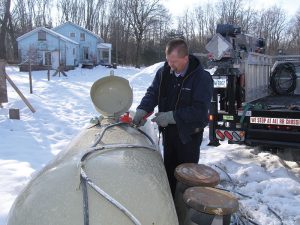Facing delivery challenges in the field
Filling customer tanks is an essential point at which we interface with customers, whether we’re delivering fuel to residences or commercial and industrial locations. The means of making those deliveries are a main focus of safety training and also of claims and lawsuits.
We see claims and lawsuits in this area for deliveries to first-time gas users, prior gas customers who are new to your company, out of gas/interruption of service calls and standard service calls. The case analysis is focused intensely on the fact pattern of how the event occurred; the origin and cause investigation; scientific testing; and industry codes, customs and practices.
Consider a recurring call your company has likely had: You receive a call to deliver 150 gallons of gas to a 500-gallon tank. Your driver arrives and notices the gauge on the tank is in the red zone (in the 5 percent range). He has no information indicating this was an out-of-gas call. He checks the bleeder valve, notes sufficient pressure and concludes the tank is not empty. He documents the tank level and his leak test on his company documents. He then fills the tank, delivers his ticket to the customer and goes to his next delivery.
CETP provides some training in this area. CETP Bobtail Delivery Operations, Lesson 2, provides that the delivery driver should “inspect the condition of the filler, pressure, relief and service valves before filling.” It specifies that the delivery driver should be sure that: all protective/rain caps are in place; there is no evidence of leakage; there is no debris blocking the valve; there are no signs of corrosion; the gasket is in place on the filler valve; and the handwheel is functioning on the service valve.”
In a recent case involving a tank fill with a similar fact pattern as discussed above, a plaintiff expert opined that the delivery driver had to check the handwheel by turning it off and on to see if it was functioning properly.
The claim was the tank was out of gas. In addition to opening the bleeder valve, had the driver turned the handwheel he would have known the tank valve was off when he went to fill it. He then would have performed a leak check, and the subsequent explosion would have been avoided.
The CETP language cited above does not specify how the driver determines that the handwheel is functioning properly. The normal practice at the time of delivery is to visually look at the valves on the tank for any obvious sign of damage to the handwheel and other valves and appurtenances. In discussing this provision with industry members, this interpretation seems to be the standard understanding of what drivers are supposed to do and what they are trained to do.
There is also a common industry practice of refurbishing tanks at customer locations during the slow season. At this time, the tanks are repainted and the various appurtenances to the tank, such as the valves and handwheel on the service valve, are replaced or repaired as needed. It is rare that a service valve handwheel is nonfunctioning.
Practically speaking, turning the handwheel off and on each time you fill a tank would create difficult issues for the industry. If you turn the valve off during this operation, you would create an interruption of service that would require a leak check of the system and, depending on company policy, may involve going into the home and relighting appliances.
As a practical matter, your company should already have a practice in place that provides your delivery drivers clear direction of what they are to do when making a delivery.
This training may consider the CETP training discussed herein or it may adopt a different procedure, provided it complies with NFPA 54 and 58 and any laws that apply to your company in the state or jurisdiction where you make fuel deliveries.
John V. McCoy is with McCoy, Leavitt, Laskey LLC. His firm represents industry members nationally. He can be reached at jmccoy@MLLlaw.com or 262-522-7007.

















